| EVE University offers a class on: | |
Logistics refers to ships and modules that provide remote repair support to other ships. "Local" repair—in which a ship repairs itself—is not considered "logistics" in EVE. In this way, logistics ships in EVE are similar to the "healer" character classes you find in many other online multiplayer games; logistics pilots usually assist their fleetmates by restoring their hitpoints during battle.
The act of hauling items is also often referred as logistics. See Hauling for details on that.
Remote Repair vs. Local Repair
One, very intuitive reason for including logistics ships in fleets is so that damage dealers can focus on their own role; by having logistics ships manage repair, the other, combat-oriented ships in the fleet can fit more modules, rigs, and implants dedicated to damage-dealing. But another, less intuitive justification is that logistics ships are often better at repairing other ships than those ships are at repairing themselves.
The biggest effect however is that a squad of logistics ships can focus all of their remote repair modules on a single target. In comparison, in a group of self-repairing ships, only the ship taking damage can use its repair modules. This makes remote repairing the only practical method of repairing in larger fleets.
Skills
- Shield Emission Systems - 5% reduction per level to capacitor consumption of remote shield boosters. Does not apply to capital modules.
- Capital Shield Emission Systems - 5% reduction per level to capacitor consumption of capital remote shield boosters.
- Remote Armor Repair Systems - 5% reduction per level to capacitor consumption of remote armor repairers. Does not apply to capital modules.
- Capital Remote Armor Repair Systems - 5% reduction per level to capacitor consumption of capital remote armor repairers. Applies only to capital modules.
- Capacitor Emission Systems - 5% reduction per level to capacitor consumption of remote capacitor transmitters. Does not apply to capital modules.
- Capital Capacitor Emission Systems - 5% reduction per level to capacitor consumption of capital remote capacitor transmitters.
- Repair Drone Operation - 5% increased repair drone repair amount per level.
In addition to the general logistics skills the hull specific racial ship skills are very important as they drastically improve logistics ship repair amounts and reduce remote repair capacitor usage.
Additionally capacitor skills are very important for logistics role. Cap chained ships receive plenty of capacitor from their capacitor transmitters but solo ships often have to rely purely on their own capacitor.
General tanking, targeting and fitting skills are of course also important.
Modules
Remote repair can be used to restore HP to a ship's shield, armor, or hull, via multiple different types of high-slot, remote repair modules. These modules have some important differences.
Remote armor repairer repairs armor on the targeted ship.
| |
| Mutadaptive remote armor repairer repairs armor on the target ship. | |
Remote shield booster repairs shield on the targeted ship.
Also comes in ancillary variant. Ancillary remote shield boosters can be loaded with capacitor booster charges. While the module has capacitor boosters it consumes no capacitor at all, but once the charges run out it consumes 2.7x as much capacitor as T2 variant. It repairs about 40% more than T2 variant even when it does not have cap charges. | |
Remote hull repairer repairs hull on the targeted ship. These types of remote repairers are almost never used.
| |
| Remote capacitor transmitter transmits capacitor to the target ship. With hull bonuses, skills and rigs these modules can be used to generate capacitor out of nothing. | |

|
Remote repair drones for shield, armor and hull come in small, light and heavy sizes totaling nine different drones. |
| Remote repair augmentor reduces capacitor usage of remote armor repairers at the cost of ship max velocity. | |
| Egress Port Maximizer reduces capacitor usage of capacitor transmitters. | |
| Drone repair augmentor Increases logistics drone repair amount at the cost of CPU capacity. | |
Implants
|
Mutadaptive Remote Armor Repairers
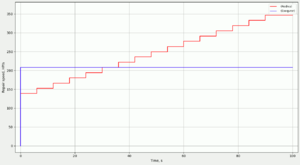
Mutadaptive Remote Armor Repairers are a type of remote armor repairer. Only Heavy (Medium) versions exists, and they can only be fitted onto a Rodiva or Zarmazd. Only one Mutadaptive Remote Armor Repairer can be fit onto a ship, which substitutes for multiple conventional remote armor repairers. The mutadaptive repairers have a spooling effect, where they will repair more HP the longer they have been active on a target. It takes 15 cycles (90 seconds) for a Mutadaptive Remote Armor Repairer to reach full strength. Mutadaptive Amor Repairers have no Falloff range and will deactivate immediately upon their target leaving optimal range, and if deactivated for any reason reset to their minimum effectiveness.
Ancillary Remote Repair Modules
Ancillary Remote Shield Boosters and Ancillary Remote Armor Repairers consume charges in exchange for repairs. In general, both ancillary remote armor repairers and ancillary remote shield boosters are used to provide a quick burst of remote repair over a few module cycles, which consume all of the module's loaded charges. Once this happens, ancillary remote repair modules must undergo an extremely slow reload before they can be used in charge-boosted mode again. As a result, ancillary remote repair modules do not improve on the overall repair rate of standard remote repair modules—the combination of boosted repair and the long reload time results in an averaged HP/time that is similar to ordinary remote repair modules—but they can be used to front-load these repairs.
Ancillary remote shield boosters (ARSBs) are loaded with cap booster charges. While many different charge sizes can fit in ARSBs, they receive no additional benefits from larger charges, so they should always be loaded with smallest charges that fit in. ARSBs have two advantages over standard, Tech I shield boosters: they deliver almost double the shield boost of a standard shield booster for 9 module cycles, and they require no capacitor when operated with cap booster charges. ARSBs also receive all of the ship bonuses that standard remote shield boosters do. These are significant advantages. Shield logistics ships are often capacitor-limited, and so delivering repairs without the need for capacitor not only helps them contribute longer, but also makes them more resistant against enemy capacitor warfare. And an initial, powerful shield boost might be just what your fleet needs at the beginning of a fight, when incoming alpha damage is at its greatest.
Nevertheless, ARSBs have some clear drawbacks. When the ARSB module runs out of cap booster charges, the logistics pilot has two choices: either wait for a 60-second reload, or use the module without charges, which costs three times as much capacitor as the standard module (Most shield logistics ships don't have enough capacitor for the second option). As is true for local ancillary repair modules, only one ARSB can be fit to a ship, so logistics pilots with an ASRB fitted will also have to use standard shield boosters. And finally, while ARSBs compare well against standard Tech I modules, they don't look quite as strong compared to meta, Tech II, faction or deadspace shield boosters; they have shorter range, and sometimes worse fitting, than many of these other options. In particular, Tech II logistics ships are probably better fit with standard shield boosters, because Tech II ships are less capacitor-limited. On the other hand, groups of Tech I ![]() Scythe pilots could benefit significantly by fitting ARSBs, so that they can boost each other through the initial wave of damage that is frequently aimed at logistics. Although ARSBs are very new and rare—they can only be manufactured from blueprint copies found via exploration or ratting—they may still find a niche in low-skill logistics.
Scythe pilots could benefit significantly by fitting ARSBs, so that they can boost each other through the initial wave of damage that is frequently aimed at logistics. Although ARSBs are very new and rare—they can only be manufactured from blueprint copies found via exploration or ratting—they may still find a niche in low-skill logistics.
Ancillary Remote Armor Repairers (ARARs) are loaded with nanite repair paste. They are similar to ARSBs in that they deliver more HP repair—more than double that of a standard, Tech I remote repair module—at the expense of charges. ARARs consume nanite repair paste instead of cap boosters, and they can only be loaded with eight cycles worth of charges instead of nine. More significantly, ARARs consume capacitor whether they are loaded with paste or not, but they only repair 1/3 as much HP when they are operated without paste. Just like ARSBs, ARARs have a 60-second reload time that limits the average repair efficiency of the modules. You can only fit a maximum of one, and ARARs compare poorly against meta, Tech II, faction and deadspace repairers in fitting and overall efficiency. But, as with ARSBs, they can be used for a short burst of repairs at the beginning of an engagement.
Remote capacitor transmitters
Remote Capacitor Transmitters consume capacitor on the fitted ship, and transfer that capacitor to a targeted fleetmate. After skill and potential hull and rig bonuses the amount of capacitor transmitted can be greater than what was consumed allowing ships with this module to generate capacitor out of nowhere.
When fit to a Caldari or Amarr logistics cruiser, on the other hand, these modules can generate hundreds of capacitor units for other ships in the fleet, at significant ranges. Most commonly, this extra capacitor is transferred to other logistics ships in a capacitor chain (or "cap chain"). In cap-chain logistics, a squad of logistics ships simultaneously give and receive capacitor to each other as a means of increasing their available capacitor.
Characteristics of different remote repair types
Logistics pilots seldom get to choose whether to fly armor or shield logistics; they are always expected to fly whatever logistics type matches their fleet's doctrine. Still, logistics pilots do have to pilot shield and armor ships differently, according to their strengths and limitations.
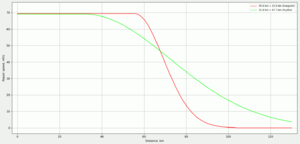
- Overall, remote shield boosters and armor repairers restore HP at the same rate. Neither of these repair modes is inherently better than the other. They do have differences, however, that make each one preferable under certain circumstances.
- Remote shield boosters deliver repair at the beginning of the module cycle while remote armor repairers deliver repair at the end of the module cycle. Due to this it is much easier to not waste repair cycles with shield boosters. One downside of flying armor logistics is that, sometimes, your armor-tanked fleetmates will die faster than the cycle time of your remote armor repair modules. When this happens, each module's repair cycle is lost; the target of the remote armor repairer no longer exists, and so when the module completes its cycle, nothing gets repaired. Another issue is over repairing where multiple repair modules get activated on the target but at the end of the module cycles only few of them are enough to bring the target back to full health, wasting the other module cycles.
- Remote armor repairers require less capacitor than remote shield boosters. Not only do armor repairers require less capacitor per cycle, they are also more cap efficient (requiring less cap per repair amount) relative to shield boosters. This means that armor-repairing ships have more cap room for other active modules, and are less sensitive to enemy neutralizers and Nosferatus, than shield-boosting ships. Because of their cap efficiency, armor logistics ships are more practical for activities where cap stability may be an issue.
- Remote shield boosters deliver more HP/cycle, so they have more repair "alpha". Combat ships are sometimes judged by how much damage they can deliver in their first ("alpha") volley. Logistics ships can be compared by a very similar measure, by how much damage they can repair in their initial repair cycle. By this measure, remote shield boosters are better than remote armor repairers—they repair more damage, right away.
- Remote armor repairers have longer optimal range than remote shield boosters. Armor logistics ships can stay farther away from the action, and still deliver 100% of their repping power, compared to shield logistics ships.
- Remote shield boosters have longer falloff range than remote armor boosters. Shield logistics ships are able to deliver partial but still good repair efficiency from further away than equivalent armor ship.
- Remote hull repairers are inferior to remote armor repairers and shield boosters, so remote hull repairers are never used in combat. Remote hull repairers require a great deal of CPU, powergrid and capacitor, and repair less HP than other repair modules. Unlike the other two remote repair types, there are no ships in EVE that are bonused for hull repair. As a result, remote hull repairers are not generally used in fleets, even for compositions focused on hull tanking.
Diminishing remote assistance
Remote shield booster, armor repairer, hull repairer and capacitor transmitter modules are subject to diminishing returns that are completely different from the usual stacking penalties. The effectiveness of these remote assistance modules will go down as the amount of assist they provide goes up.
The rate at which their effectiveness is reduced is not very significant. For capital modules the effect becomes notable at around 30 remote repairers (10 FAX) and for subcapital remote repairers it becomes notable when there are well over 100 remote repairers used on single target. [1]
Logistics Ships
Each of the four player races specializes in the type of logistics that their ships are naturally tanked for. Caldari and Minmatar ships are ordinarily shield-tanked, and so these two races specialize in shield logistics; and Amarr and Gallente ships are typically armor-tanked, so these two races specialize in armor logistics. In addition, each race specializes in either cap-chain logistics, or not. It is important to note that capacitor chaining only works for Logistics Cruisers; all frigate logistics ships, of all races, are "solo" logistics ships.
Race Armor or Shield? Cap-Chain
or Solo?
Armor Cap-Chain 
Shield Cap-Chain 
Armor Solo 
Shield Solo 
Armor Solo
Tech I Logistics Frigates
Each of the four empire factions has a Tech I frigate dedicated to logistics. The bonuses for the two Tech I shield logistics frigates—the ![]() Bantam and the
Bantam and the ![]() Burst—are identical, as are the bonuses for the two Tech I armor logistics frigates, the
Burst—are identical, as are the bonuses for the two Tech I armor logistics frigates, the ![]() Inquisitor and the
Inquisitor and the ![]() Navitas. The most common fits for the four ships are also very similar. In general, the Burst and Inquisitor are slightly favored over the other two because of advantages in speed (Burst) and capacitor and tank (Inquisitor).
Navitas. The most common fits for the four ships are also very similar. In general, the Burst and Inquisitor are slightly favored over the other two because of advantages in speed (Burst) and capacitor and tank (Inquisitor).
Logistics frigates have the least repairing power and shortest range out of all the logistics ships, but they do have the advantage of being very inexpensive and difficult to hit (like any other Tech I frigate).
A Tech I logistics frigate can repair the damage caused by one or two opponents at most, at short range.
Shield logistics frigates have very short optimal ranges, so they usually operate from falloff range can almost never apply their full repair capacity. Pilots with poor capacitor skills, or low skills in the appropriate racial frigate skill or in ![]() Shield Emission Systems or
Shield Emission Systems or ![]() Remote Armor Repair Systems, will have trouble with capacitor even if they use all "Enduring" meta versions of all active modules.
Remote Armor Repair Systems, will have trouble with capacitor even if they use all "Enduring" meta versions of all active modules.
Still, there are a few roles that Tech I logistics frigates fill uniquely well. Logistics frigates are better than logistics cruisers in gangs of frigate and destroyer damage dealers, because they have the speed to keep up, particularly when fitted with microwarpdrives.
Tech II Logistics Frigates
Tech II logistics frigates improve on their Tech I counterparts in a number of ways. They have considerably more CPU and powergrid, and one more fitting slot, relative to the Tech I frigates. Tech II logistics frigates also have some unique bonuses relative to Tech I frigates. Flying a Tech II logistics frigate requires a dedicated skill, ![]() Logistics Frigates. Because this skill contributes significantly to bonuses in this ship class, pilots are encouraged to train it to IV or V before flying a Tech II logistics frigate.
Logistics Frigates. Because this skill contributes significantly to bonuses in this ship class, pilots are encouraged to train it to IV or V before flying a Tech II logistics frigate.
The repair bonuses, repair range and base velocity of Tech II logistics frigates aren't dramatically better than those of their Tech I relatives. Increased CPU and powergrid do mean that Tech II logistics frigates can fit better repair modules than Tech I ships. Tech II modules increase the repair rate of Tech II logistics frigates, and deadspace repair modules increase it further still. Nevertheless, even fit with rare modules, a Tech II logistics frigate repairs no faster than a Tech I logistics cruiser, with shorter range and higher cost. These frigates—and particularly the ![]() Deacon, the most popular of the four—are still used in small-ship gangs.
Deacon, the most popular of the four—are still used in small-ship gangs.
Tech I Logistics Cruisers
Tech I logistics cruisers are powerful platforms for remote repair. They are inexpensive, and relatively easy to skill into. As mentioned at the beginning of this Ships section, logistics cruisers can either be "solo" or cap-chain ships.
The ![]() Scythe and the
Scythe and the ![]() Exequror are the two Tech I logistics cruisers that are not bonused for remote capacitor transfer. They can be simpler to pilot than the cap-chain cruisers. But the performance of all of the logistics cruisers is sensitive to pilot skill, and pilots with different skill levels sometimes have to fly even these simpler hulls differently.
Exequror are the two Tech I logistics cruisers that are not bonused for remote capacitor transfer. They can be simpler to pilot than the cap-chain cruisers. But the performance of all of the logistics cruisers is sensitive to pilot skill, and pilots with different skill levels sometimes have to fly even these simpler hulls differently.
The Scythe and Exequror are very similar, with roughly the same ship bonuses and repair capacity. As is true for all logistics ships, the shield-boosting Scythe has a shorter optimal range and a longer falloff, whereas the armor-repairing Exequror has a much longer optimal range, but shorter falloff. The role bonuses that logistics cruisers receive to repairer range makes both of these cruisers excellent at repairing from a distance, and the bonuses do not depend on pilot skill level. Repair rate, on the other hand, is very sensitive to pilot skill.
Tech I logistics cruisers offer more flexibility in fitting than logistics frigates. As a result, pilots with different skill levels may find that they need to fit their ships differently, making compromises between tank and capacitor or sustained capacitor regen versus burst capacitor from capacitor booster.
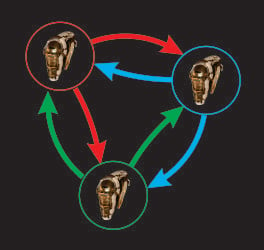
The ![]() Osprey and the
Osprey and the ![]() Augoror are the two Tech I logistics cruisers that are bonused for remote capacitor transfer. As described above, these bonuses allow the Osprey and Augoror to activate their remote capacitor transfer modules, transfer more capacitor than they spend, and thus effectively create capacitor from nothing.
Augoror are the two Tech I logistics cruisers that are bonused for remote capacitor transfer. As described above, these bonuses allow the Osprey and Augoror to activate their remote capacitor transfer modules, transfer more capacitor than they spend, and thus effectively create capacitor from nothing.
Cap chaining solves the capacitor challenges of solo logistics cruisers. Pilots of all skill levels receive this benefit, because the role bonuses to remote capacitor transfer do not depend on skill level. Often this makes cap chaining logistics ships much less skill intensive than solo logistics ships.
In order for a logistics pilot to benefit from this, the pilot must simultaneously give capacitor to and receive capacitor from one or more logistics partners. In principle, the minimum number of partnered logistics pilots is two, but cap-chain logistics is less vulnerable to enemy interference when larger groups of pilots are matched up. So, Osprey and Augoror pilots are typically organized into a capacitor chain (illustrated at right), in which each pilot gives and receives capacitor with two neighboring partners in the chain. The cap chained logistics ships can even periodically break the chain in order to transfer capacitor to damage-dealing fleetmates that need the help.
But in order for cap-chain logistics cruisers to be cap-stable, they must be partnered, and this represents a vulnerability for these ships. Enemy fleets can break the cap chain, either by isolating chain members, using electronic warfare, by splitting them up using command destroyers with micro jump field generators, or by simply killing them. Cap-chain logistics ships are often specially fit to counter some of these strategies. For example, sensor boosters can counter EWAR and a warp scrambler can counter a micro jump field. In any case, cap-chain logistics pilots are dependent on their fleetmates, and keeping cap chains intact under enemy fire can make them challenging to fly.
Tech II Logistics Cruisers
Tech II logistics cruisers are the most powerful sub-capital repair ships in EVE. Tech II logistics cruisers have increased tank, CPU and powergrid, and better bonuses compared to Tech I logistics cruisers. Flying these ships requires training in a dedicated skill, ![]() Logistics Cruisers. Unistas are encouraged to train this skill to IV before attempting to fly Tech II logistics cruisers. When flown by pilots with sufficient skills, Tech II logistics cruisers have considerably more repair capacity than their Tech I relatives. They also have even more fitting flexibility than Tech I cruisers, and are typically fit specifically to their role. Unique among logistics ships, Tech II cruisers can fit over-sized, large remote repair and remote capacitor transfer modules instead of medium ones. As a result of this diversity, specific comparisons of Tech II logistics cruiser fits are beyond the scope of this article.
Logistics Cruisers. Unistas are encouraged to train this skill to IV before attempting to fly Tech II logistics cruisers. When flown by pilots with sufficient skills, Tech II logistics cruisers have considerably more repair capacity than their Tech I relatives. They also have even more fitting flexibility than Tech I cruisers, and are typically fit specifically to their role. Unique among logistics ships, Tech II cruisers can fit over-sized, large remote repair and remote capacitor transfer modules instead of medium ones. As a result of this diversity, specific comparisons of Tech II logistics cruiser fits are beyond the scope of this article.
Tech II logistics cruisers follow the same racial specializations as their Tech I relatives. The ![]() Scimitar and
Scimitar and ![]() Oneiros are "solo" logistics ships, and the
Oneiros are "solo" logistics ships, and the ![]() Basilisk and
Basilisk and ![]() Guardian are cap-chain specialists.
Guardian are cap-chain specialists.
The solo Tech II logistics cruisers are like the solo Tech I cruisers, in that they are intended to operate independently, and often have to make tradeoffs between capacitor and tank in their fits. The ![]() Scimitar and
Scimitar and ![]() Oneiros are strongest in smaller gangs of Tech II and Tech III damage dealers, where there is only room for one or two logistics pilots.
Oneiros are strongest in smaller gangs of Tech II and Tech III damage dealers, where there is only room for one or two logistics pilots.
The cap-chain Tech II logistics cruisers are like their cap-chain Tech I relatives, in that they must work in groups, and they have enough capacitor to sustain a fit full of high-capacitor-demand modules. These cruisers have the broadest array of options in terms of modules they can fit. Tech II logistics pilots can fit faction, deadspace, or large-sized repair modules to the ![]() Basilisk and
Basilisk and ![]() Guardian comfortably. These ships are strongest in large Tech II/III fleets, in high-skill PvE, and in medium-sized wormhole gangs where the group is expected to be able to handle incoming DPS.
Guardian comfortably. These ships are strongest in large Tech II/III fleets, in high-skill PvE, and in medium-sized wormhole gangs where the group is expected to be able to handle incoming DPS.
Triglavian Logistics Ships
The Triglavian Collective offers a Tech I and a Tech II logistics ship: the ![]() Rodiva and
Rodiva and ![]() Zarmazd. Both of these ships use the Heavy Mutadaptive Remote Armor Repairer, and both rely on local cap regeneration rather than a cap chain, however they have very different use cases than other logistics cruisers. The Rodiva acts similarly to an Exequeror or Oneiros, able to support a small gang either alone or in a pair, and can also somewhat defend itself using its drones. The Zarmazd has extremely thick armor, can apply high-powered repairs to an armor fleet, and brings a ridiculous range of other utilities, in particular including Smartbombs to push hostile drones away from friendly logistics ships. However, Triglavian logistics have a severe weakness relative to other logistics ships: when first activated, their single repair module is only as strong as 2 normal remote repair modules, and takes a full 90 seconds to reach its full strength (of 5 normal remote repair modules). This very long delay before reaching full strength means that Triglavian logistics are extremely bad at "catching" an allied ship when it first starts taking damage, and are thus also very bad at dealing with enemy fleets which change targets frequently. However, they can be very effective as secondary logistics ships, either at keeping a pre-selected allied ship alive against all opposition, or at holding an allied ship after it had been "caught" (by friendly Guardians most likely) thus freeing other logistics ships to be ready for a target swap, or at counteracting the slowly ramping damage of Triglavian Entropic Disintegrators.
Zarmazd. Both of these ships use the Heavy Mutadaptive Remote Armor Repairer, and both rely on local cap regeneration rather than a cap chain, however they have very different use cases than other logistics cruisers. The Rodiva acts similarly to an Exequeror or Oneiros, able to support a small gang either alone or in a pair, and can also somewhat defend itself using its drones. The Zarmazd has extremely thick armor, can apply high-powered repairs to an armor fleet, and brings a ridiculous range of other utilities, in particular including Smartbombs to push hostile drones away from friendly logistics ships. However, Triglavian logistics have a severe weakness relative to other logistics ships: when first activated, their single repair module is only as strong as 2 normal remote repair modules, and takes a full 90 seconds to reach its full strength (of 5 normal remote repair modules). This very long delay before reaching full strength means that Triglavian logistics are extremely bad at "catching" an allied ship when it first starts taking damage, and are thus also very bad at dealing with enemy fleets which change targets frequently. However, they can be very effective as secondary logistics ships, either at keeping a pre-selected allied ship alive against all opposition, or at holding an allied ship after it had been "caught" (by friendly Guardians most likely) thus freeing other logistics ships to be ready for a target swap, or at counteracting the slowly ramping damage of Triglavian Entropic Disintegrators.
Bonused and Unbonused Battleship Logistics
In contrast to the variety of bonused logistics hulls available in frigate and cruiser sizes, there are only two battleship-size hulls bonused for logistics: the ![]() Nestor and
Nestor and ![]() Orca. The bonuses of the Nestor battleship are not that great, and the hull can be expensive. The Nestor is used rarely when a very heavy armor tank, beyond what the Guardian can do, is needed. The Orca is almost never used in primary logistics role, but it can help defend barges in a mining fleet.
Orca. The bonuses of the Nestor battleship are not that great, and the hull can be expensive. The Nestor is used rarely when a very heavy armor tank, beyond what the Guardian can do, is needed. The Orca is almost never used in primary logistics role, but it can help defend barges in a mining fleet.
Remote repair modules are sometimes fitted to unbonused battleship hulls as part of "spider-tanking" fleet doctrines. The ![]() Dominix, in particular, works well with remote repairers and remote cap transmitters, because it relies on bonused drones for its main DPS, and has no bonuses for hull-mounted weapons.
Dominix, in particular, works well with remote repairers and remote cap transmitters, because it relies on bonused drones for its main DPS, and has no bonuses for hull-mounted weapons.
Capital Logistics: Force Auxiliaries
Force Auxiliaries are a class of capital ship dedicated to logistics. Force auxiliaries are the only capital ship class to receive bonuses to remote repairing. They are also the only capitals able to use triage modules, which enhance the defensive and remote repair capabilities of the ship for five minutes, but also make the ship incapable of receiving remote assistance. Force auxiliaries and triage modules are discussed in more detail in the Force Auxiliaries article.
Logistics and crimewatch
Assuming their safeties are set to the appropriate level, logistics pilots inherit the timers of the pilots they repair. If the repaired ship is engaged in combat, the logistics pilot will almost certainly receive log off, Weapons, and Limited Engagement timers. In addition, if repair occurs in high-security space, and the logistics pilot is not legally allowed to engage all of the repaired ship's combat targets either due to war or limited engagement (suspect timer is not enough) the logistics pilot will become criminal and will be killed by CONCORD, even if neither of the engaged pilots were criminals. As a result, logistics pilots occasionally have to think about how repair affects other, non-aligned pilots in system. Your logistics ship may end up attackable by parties in system that you did not expect including CONCORD.
It is not recommended to ever set safeties to red as a logistics pilot. The only situation where red safeties would do anything over yellow safeties will result in logistics pilot being killed by CONCORD. In high security space it is common to keep the safeties green to avoid logi becoming suspect and being killed by third party combatants.
Logistics modules follow same rules of engagement as other remote assistance modules. See Remote assistance for more details on crimewatch and logistics interact.
Logistics organization and tactics
Logistics pilots have the greatest impact when they work well within their fleet. As a result, a good understanding of the fleet's organization, mechanics, and the fleet interface is essential for logistics pilots. Familiarity with The Rookie's Guide To Fleet Ops is recommended, as well as guide on the Fleet interface.
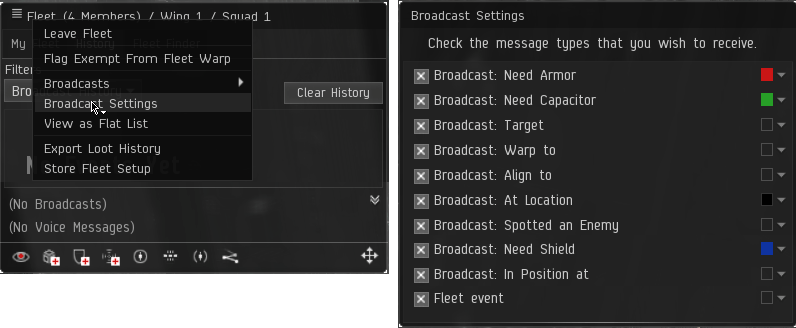
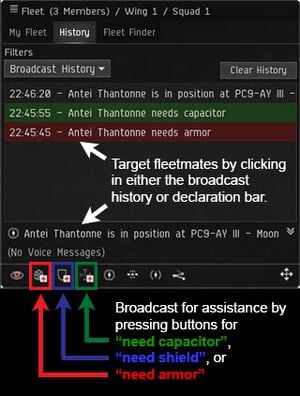
Prepare and use your fleet window.
If your gang is small enough, your fleetmates may be able to request repairs in comms ("Hey, Bob! John needs reps!"). But in even a medium-sized fleet, comms are intended for communication between FC(s) and the rest of the fleet. Under these circumstances, fleetmates "broadcast for repairs" through the Fleet window. You can see their requests under the window's History tab. As described in the Fleet interface, use the Broadcast Settings window to make the "Need Armor", "Need Shield", and "Need Capacitor" broadcasts show up with distinct color backgrounds. When one of these broadcasts is listed in the Fleet History window, you can Ctrl -click the broadcast to lock that pilot and immediately provide repairs or capacitor. Once your fleetmate no longer needs assistance -maybe because the enemy fleet has shifted targets— they will broadcast "In Position At". You will need to watch the Fleet window for this signal, and be prepared to switch the focus of your remote support. This applies when other fleetmates need repairs.
When you are the one needing repairs because you are the enemy's primary target, you will be the one broadcasting.
Fill your watchlist
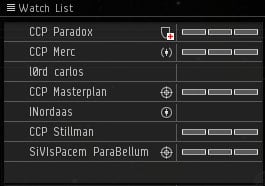
The Watchlist is a window that allows you to monitor the shield, armor and hull HP of fleetmates that are on grid with you, without having to lock them. In addition, clicking on names in the Watchlist window has the same effect as selecting them in space or in the Overview window, which makes interacting with these particular pilots very easy. The Watchlist is an extremely important tool for logistics pilots, and will allow you to identify fleetmates that need repairs even before they identify themselves.
Fleetmates can be added to your Watchlist by right-clicking on the pilot name and selecting "Add to Watchlist" or by dragging the name into the watchlist window. Unfortunately, the Watchlist can only hold 15 pilots. If you are flying logistics in a small gang, this may be enough space to list your entire fleet. But if you are in a larger fleet, you will need to choose who to include (or you will need to follow the FC's or logi captain's instructions on who to add). In general, you will be asked to include fleet, wing, and squad commanders on your watchlist first, because they are critical to passing fleet boosts to the fleet. You will then probably add your fellow logistics pilots, because they are so often the primary targets of the opposing fleet. Finish out your list with any critical damage dealers or other special pilots you expect to need early repairs.
Know your optimal and falloff ranges, and what distance you and your fellow logistics pilots plan to repair from
As described above, different logistics hulls and modules have different characteristic repair ranges. Know how far from your damage-dealing fleetmates you plan to be.
Warp into the engagement at the appropriate range, opposite the enemy
The FC will likely warp the fleet's damage dealers at their weapons' optimal range. You will need to be behind those damage dealers, so ignore the FC's fleet warp instructions to the damage-dealing group. (You might do this by canceling the fleet warp once it starts, or the FC may have organized wings and squads so that the logistics group warps separately.) You will warp at your own range to your fleetmates, with them in between you and the enemy. If you are flying armor logistics, this will probably be at your repair modules' optimal range. If you are flying shield logistics, your range will be dictated by the FC, but (optimal + half-falloff) is a good rule of thumb.
If there are multiple logistics pilots, orbit the nominated logi anchor
Before the fleet gets underway, the FC should have named a logistics "anchor"—a pilot that logistics ships should orbit at close distance. In this way, only the anchor pilot is responsible for positioning the logistics group, and all the other pilots simply follow that anchor. (The logi anchor may or may not be the same as the logi commander.) The situation can get more complicated if your opponent's field Command Destroyers, which use Micro Jump Fields to separate clustered logistics ships from their fleetmates; if the FC orders you to spread out, that might be why. But at least initially, stick to your anchor.
If you fall behind the rest of the fleet, out of repair distance, warp out and back in
Logistics ships are sometimes slower than the rest of the fleet, especially when they are fitted with afterburners instead of microwarpdrives. If you fall behind, try to warp to a tactical bookmark behind the logistics group, and then warp back to a damage dealer at closer range than you need. (This ensures that your fleetmate won't just race away from you again.)
Watch your capacitor
Capacitor regenerates fastest when it is at 25% of maximum, but very slowly at 0%. Don't allow your capacitor to drop too much below 25%. You may need to deactivate one repair module for a while, deactivate an active resist module that you realize you don't need vs. the opponents' damage type, or be more conservative with your propulsion module. If you cap yourself out, you won't be able to activate anything—you'll be a sitting duck. Don't let that happen!
Stagger your repair modules' activation, if you can
Repair modules can have pretty long activation times. If you activate them all at once, it might be 8 seconds before you can re-target them to a different fleetmate who calls for emergency reps. By staggering your repair modules, you can gradually shift the target of your repairs. Staggering also evens out the load on your capacitor and avoids over repairing targets that don't need all your repairs at once.
If you are the target of a specialized ship or tactic, communicate that with the logi leader or FC
If you find that a specific enemy ship is taking you out of the fight with neuts or EWAR, tell the FC (preferably in fleet/logi chat); the fleet may be able to switch targets to take out the threat, or your FC may have other instructions for you.
Don't forget to launch and use your drones!
Organize for cap-chain logistics
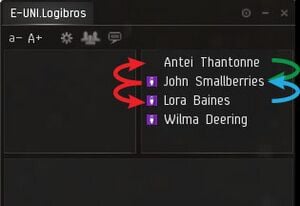
As explained before, cap-chain ships have the advantage of abundant capacitor and they seldom have to worry about having to cycle modules on and off. But cap-chain logistics pilots do have an extra layer of complexity to deal with: maintaining the capacitor chain. There are a few ways to do this, but the most common method is to organize cap-transfer partners in a dedicated logistics chat channel set up by the logi commander. Once you are in this channel, the names above and below yours in the Member List are your transfer partners (assuming a 1-up, 1-down transfer scheme—your FC could choose a different one). Members at the very top and very bottom of the member list are also partnered. The advantage of using a chat channel is that members can drop out of the channel when they are destroyed or otherwise incapacitated, and the remaining, neighboring pilots can adjust by obtaining a new cap-transfer partner from the member list.
References
- ^ Devblog: Spring Balance Update Incoming! (2019-03-13)
